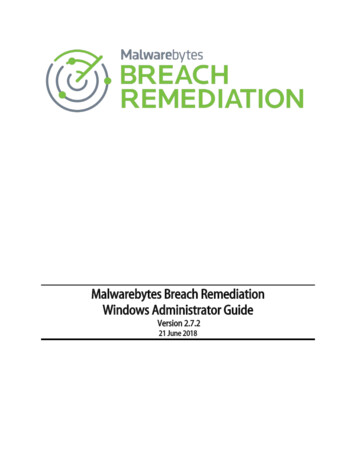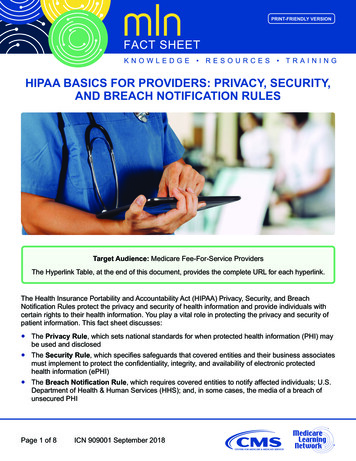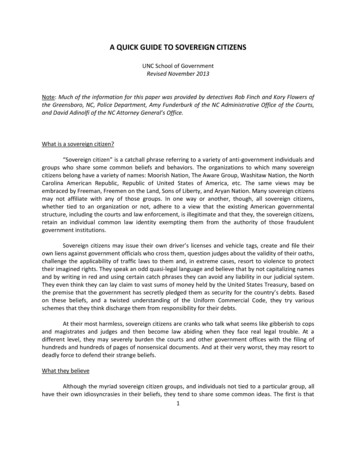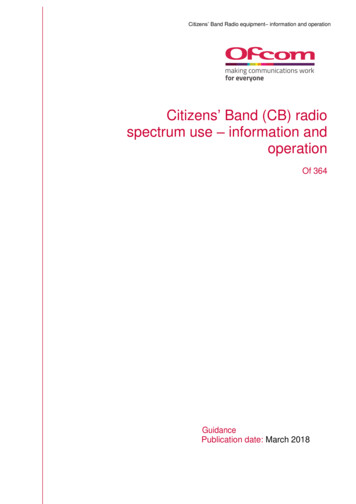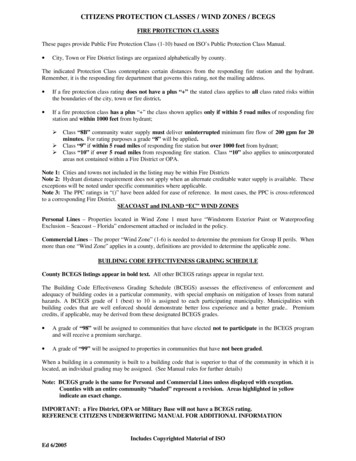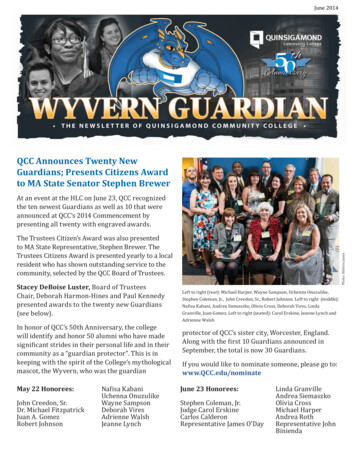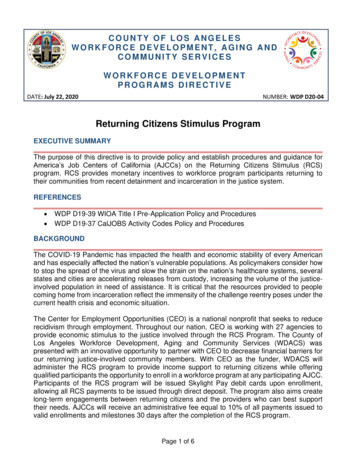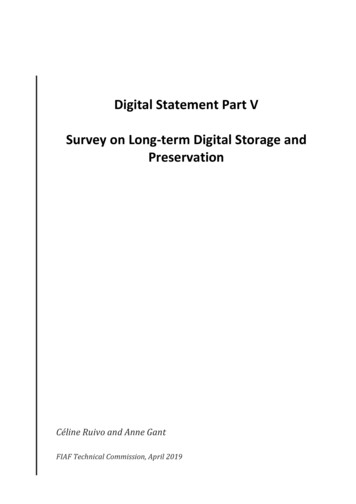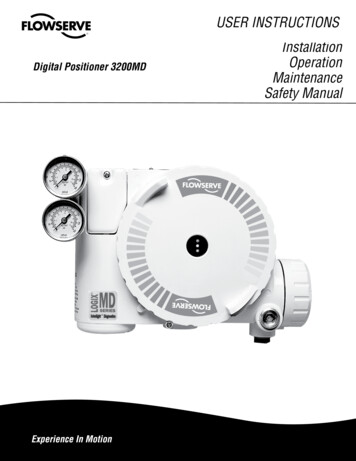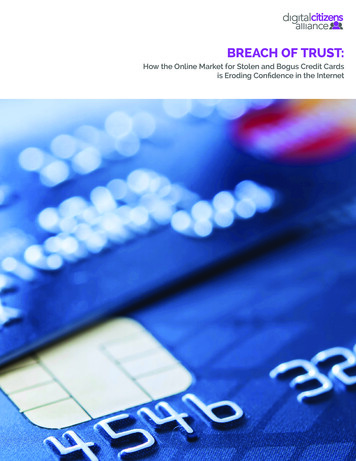
Transcription
BREACH OF TRUST:How the Online Market for Stolen and Bogus Credit Cardsis Eroding Confidence in the Internet
When Target acknowledged in January that a hacker had accessed credit card information for 70million Americans, it created a firestorm of worry about the dangers of credit card theft, shakingconsumer confidence and devastating Target’s sales.The fallout was remarkable: More than 80 lawsuits were filed against the company, Target’s profit fell 46percent as it spent over 61 million to address the breach.The credit card breach has done remarkable harm to what had been a strong, respected brand. So justimagine what Target executives and employees must think when they see this:On June 2, Digital Citizens’ researchers found this Target advertisement running alongside a videopushing credit cards, social security numbers, and bank logins on Youtube. When we clicked on the ad,we went directly to Target’s website. At a time when the company is spending billions to regain trust,how does something like this undermine Target’s investment?Now here’s the bad news – and it applies to all retailers as well as consumers.This problem will continue – no matter how much retailers invest in security – as long as criminals canfind a place they can easily sell their stolen credit cards.The unholy alliance between hackers stealing credit card numbers and online markets advertising stolenand bogus credit cards has existed right under our noses. Hackers have been promoting the sale ofstolen or bogus credit cards on online markets for years, including on some of our most popular onlinewebsites such as YouTube.Now here’s the worse news.When someone stumbles onto videos marketing stolen credit cards, as well as other stolen andillegal items displayed on YouTube, the site’s parent company, Google, makes money. After seeing inprevious Digital Citizens Alliance reports ads running next to videos pushing rogue online pharmacies,performance enhancing drugs, fake passports, and various other items, reporters and law enforcementtried to get answers from Google about this activity.2
Harvard Business School Professor Ben Edelman estimates that Google’s revenue from the illegalactivities of others exceeds 1 billion dollars.1 This has gotten the attention of state attorneys general(AGs), which have asked how much money Google makes from illegal activities. Last year, Googleresponded to a request from AGs by saying it was “burdensome” to provide a “complete answer” onhow much the company makes from illegal activity on YouTube. 2But one thing is clear: there is a supply and demand for stolen and bogus credit cards that posesa threat to American consumers. It goes beyond Target, because the problem existed long beforesecurity expert and blogger Brian Krebs exposed the Target breach. It has existed for years, right infront of us, and is getting worse, not better.And perhaps most troubling, it’s starting to have an impact on how Americans view online shopping.According to a recent Zogby Analytics survey commissioned by the Digital Citizens Alliance,Americans are worried about whether online shopping is becoming too risky: 84 percent of Americans called the issue of thieves hacking into retailers to steal cardnumbers or stolen credit card numbers showing up online a “serious” issue, with 58 percentcalling it “very serious.” 37 percent of Americans report that they have had their credit card stolen or compromised.Nearly half of those said they never an explanation for or discovered the cause of the theftor compromise. Nearly half of all Americans – 48 percent – say that the prospect of credit card theft orfraud has made them more reluctant to make an online purchase.ANATOMY OF A HACK/CARD GENERATOROnce hackers get credit card information, they can clone the information onto a new physical cardand use it in stores to buy electronics, clothes, etc. that they can then easily resell for cash.Krebs detailed that “crooks often use stolen dumps to purchase high-priced items such as Xboxconsoles and high-dollar amount gift cards, goods that can be fenced, auctioned or otherwiseoffloaded quickly and easily for cash.”Or, they can simply use the information online to make the same purchases without having to createphysical cards and exposing themselves and go directly to ATM’s and pull out as much cash aspossible using the stolen debit or credit information.In other cases, credit card numbers are generated to create numbers that mimic real credit cards inorder to fool validation algorithms on websites that require you to enter a CC number to join, but thatdon’t charge you. They are used to avoid giving out their real information.They are not tied to an actual credit or bank account so they cannot be used for real purchases. Inthe majority of these cases this service is free. When you have to pay for it is when you should becareful.SILK ROAD - OR YOUTUBE?These revelations are troubling because our society is invested in the Internet for our future, withmuch of our economic growth - which means jobs and a solid future for the next generation - tied tothe success or failure of our trust with doing things online.But Americans also expect one more thing: 69 percent surveyed said that websites such as YouTube“should not be in the business of advertising or promoting stolen or fraudulent credit l-or-objectionable-content/article/38730563
But, unfortunately, they are. YouTube is infested with videos promoting the sale of credit cards.YouTube is one of the most popular websites in the world3 and the most popular amongst teens.4 Manymarketers of all types see YouTube as a virtual mall where you can not only sell products, but alsodemonstrate to “shoppers” how those products can be used. That makes it that much more troublingthat it is so easy to find and buy credit card numbers on YouTube.Below are the terms that we searched and the results:“how to get credit card numbers that work 2014”15,900 Results“CC info with CVV”8,820 Results“Buy cc numbers”4,850 Results“CC number with CVV5”4,160 Results“CC Fullz6”2,030 Results“CC Fullz and bank login”1,790 Results“CC with CVV and SSN7”785 ResultsAnd many of these videos are embedded with advertisements, which means that Google is effectivelyin business with crooks peddling stolen or bogus credit among-teenagers-facebookCVV Card Verification ValueAccording to creditcards.com, Fullz is “a slang term used by hackers meaning full packages of individuals’ identifying information.”SSN Social Security Number4
HOW?Google’s business is built on ads, and YouTube is just one platform that contributes to the 55 billion inannual sales. YouTube receives more than a billion unique visitors each month. Google makes money byselling ads – to a search term, or a video. Think about when you click on a YouTube video. Sometimesyou have to watch an ad before it will run, sometimes there is a banner ad that shows up on the bottomduring the video, and other times there are ads that run around the video.If enough viewers click on those ads, Google will split the ad revenue with the video producer – in thiscase the crooks that are peddling credit cards.Here is an example:In this screen shot, the search term is “buy cc numbers.” The video producer’s video is entitled “buycredit cards and social security numbers online” and has been up on YouTube since December 2013.The advertising is on the right and embedded in the video.Look at the ad embedded in the video. It’s for American Express. That means Amex is paying Googleto advertise on a YouTube video promoting the illegal sale of credit cards. It is fair to assume that Amexdidn’t think that’s where its advertising dollars would go.But this isn’t the only video peddling credit cards, and Amex isn’t the only credit card issuer to beassociated with it.5
The video below shows an ad for the Discover Card embedded in the video.Note that the video has been up on YouTube since October 2012.This next video below promoting credit cards for sale includes ads for both United Airlines and theKennedy Center. In both cases, the advertiser is seeking online sales, but presumably not from thestolen or bogus credit cards that are being peddled on this video.Note that the prior video has been on YouTube since March 2012 and had nearly 2,700 views in that time.6
Once the video is on YouTube, other credit card peddlers (or scammers) flood the comment sectiontrying to promote their “businesses.” Here are some comments from the prior video.Amazon is the world’s largest online retailer, selling nearly 70 billion in goods and services a year. Giventheir reliance on online commerce, it’s unlikely they’d appreciate their advertising showing up on videooffering the illegal sale of credit cards, as occurs in the video below.Note that this video has been on YouTube since June 2012, and the video producer’s email is“h4ckercc@yahoo.com.”7
Numerous other brands show up on videos peddling illegal credit cards, from KPMG to Google itself, asshown in the screenshot below. Google should know when its ads show up on its own platform.Note the Google AdWords video embedded in the video and that while the video has only been upsince January 2014, it already has more than 23,000 views.In some ways, YouTube is mimicking essentially the types of illegal goods associated with “darknet” sitessuch as Silk Road.Over the past year, Digital Citizens has raised issues around what is sold on the Internet, from theobscure “darknet” sites such as Silk Road to mainstream sites such as YouTube. Whether mysteriousor popular, they seem to have one thing in common: a desire to make money, regardless of theconsequences or criticism.8
WHAT’S TO BE DONE?Silk Road was raided by the FBI, only to resurface stronger than ever.In Google’s case, in each instance when the company has been confronted with examples of illegal ordangerous goods and services being sold on YouTube – whether prescription painkillers, steroids, fakepassports, forged documents, escort services, or counterfits – Google’s response has been the same: First, scrub YouTube to remove controversial videos to stop the criticism and scrutiny.Ultimately, the videos make their way back onto YouTube in ensuing months. Second, put out a statement trumpeting all the company is doing to make YouTube safe.Here’s the statement they’ll put out after this report is published:“We take user safety seriously and have Guidelines that prohibit any content encouragingdangerous, illegal activities This includes content promoting the sale of drugs. YouTube’s reviewteams respond to videos flagged for our attention around the clock, removing millions of videoseach year that violate our policies. We also have stringent advertising guidelines, and work toprevent ads appearing against any video, channel or page once we determine that the content isnot appropriate for our advertising partners.”8That’s an excellent statement, with just one problem: if Google was actually doing all it could thesevideos wouldn’t exist on YouTube. Once again, Google has to start treating this less like a PR problem tobe managed, and more like an Internet safety problem that poses risks and dangers to its users.Asking Google to stop posting – and profiting – from YouTube videos promoting illegal and dangerousactivities seems pointless at this time since they have ignored previous calls to action.The next stage then seems to be outreach to the brands who certainly don’t want to be featuredon YouTube videos promoting credit card theft and fraud, illegal drug sales, steroids, escorts orcounterfeits.Our next step as Digital Citizens is to start working with the brands, raising their awareness to theproblem and hopefully convincing them to urge Google to step up and take responsibility.Digital Citizens knows that Google faces a tough job.Millions of hours of video are downloaded each day onto YouTube. But it’s frankly a cop-out for Googleto say they can do nothing. Simply flagging videos with search terms such as “buy stolen credit cards,”“buy fake passports,” and “buy prescription drugs without a prescription” for closer review before theyare uploaded would make a dent in the problem. But it appears Google would rather take a handsoff approach, perhaps out of fear that taking some responsibility will lead to a slippery slope of moreresponsibility.After authorities challenged Google to crackdown on rogue online pharmacies, the company had toshell out 500 million dollars. That’s when Google says it cracked down on such ads. It claims in 2010,ads from unlicensed pharmacies have dropped by 99.9 percent.9 When Google decides that a crimeis serious, like illegal pharmacies and child pornography, it takes action. Isn’t it time that Google stopsjudging which crimes are serious enough for action and which are tolerable consequences? And just asimportantly, isn’t it time that they stop profiting from /Also: /; ea876a8f30 story.html; ?m y&smobile y; sales/
“Buy cc numbers” 4,850 Results “CC number with CVV5” 4,160 Results “CC Fullz6” 2,030 Results “CC Fullz and bank login” 1,790 Results “CC with CVV and SSN7” 785 Results And many of these videos are embedded with advertisements, which means that Google is effectively in business with crooks peddling stolen or bogus credit cards.
